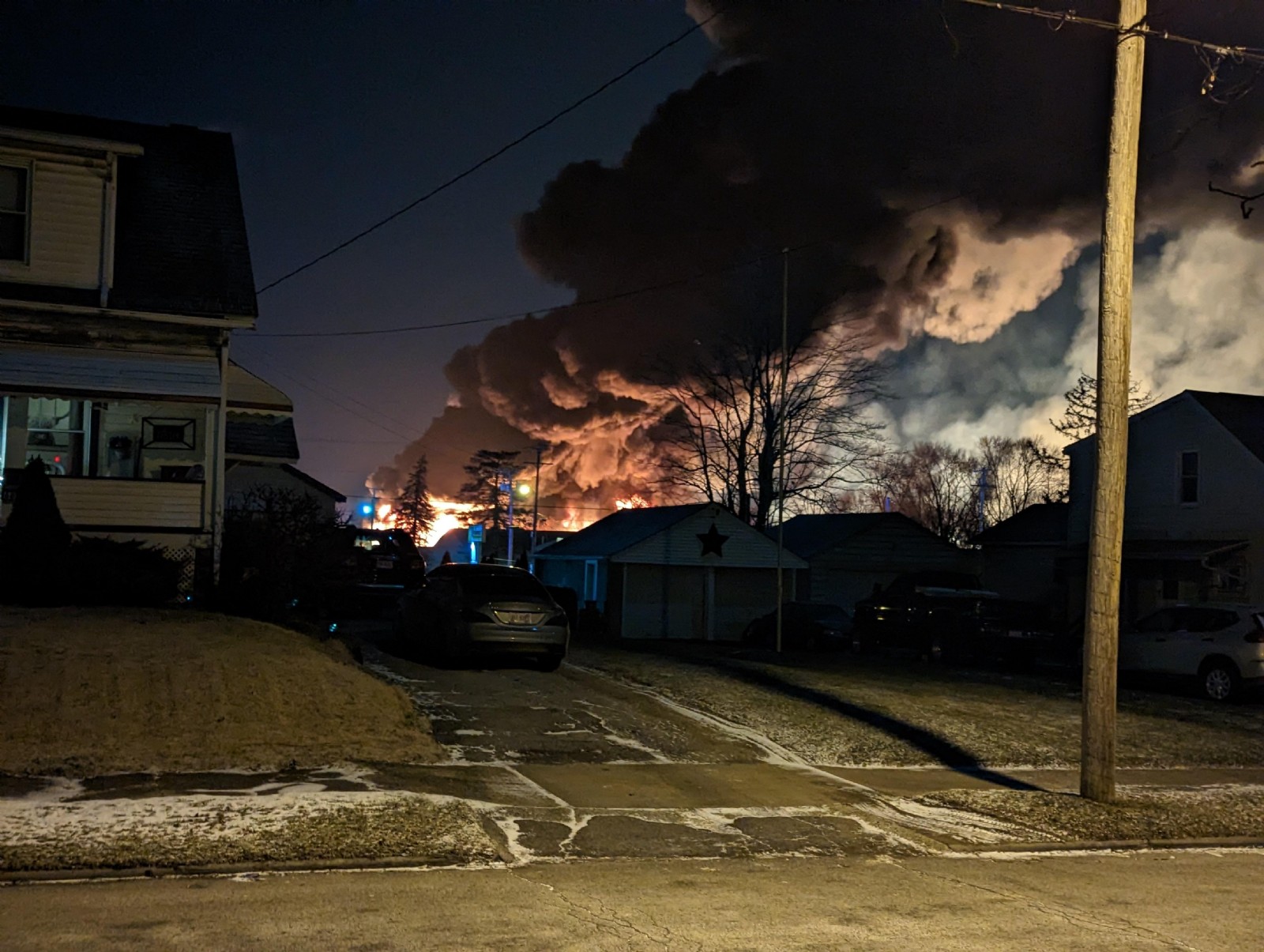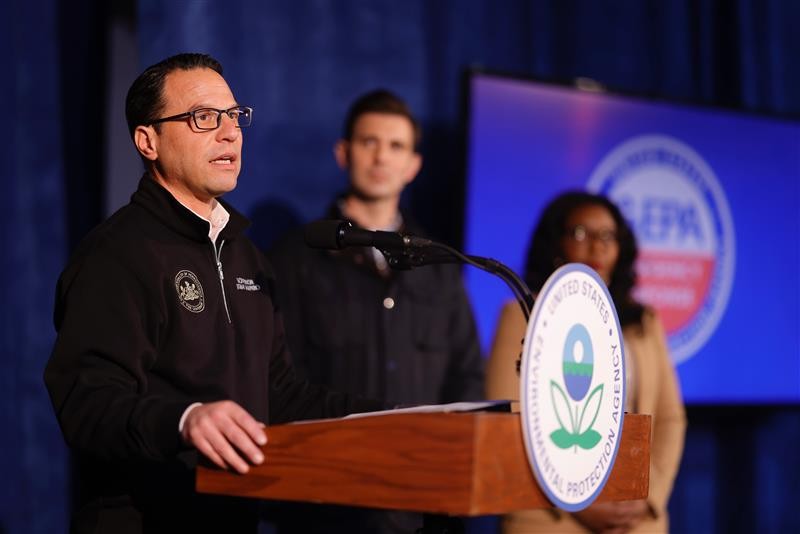PennFuture Blog
Our Perspectives on the Latest Issues
The East Palestine, Ohio train derailment disaster is shocking in its scale and potential effects. Unfortunately, we may not know this disaster's long-term health and environmental impacts for months or even years.
The gradual release and burn of these chemicals increased the risk that they spread beyond the crash site. With butyl acrylate found in local surface water, testing the groundwater supply and subsoil is crucial. We encourage anyone concerned about pollution and the safety of their community to document their observations and request soil and well water testing from the U.S. Environmental Protection Agency (EPA).
The residents of East Palestine and neighboring communities deserve transparency around the EPA's plan for continued air quality monitoring and the data of air tests.
Regardless of location and as a regular practice, residents should report any unusual odor or changes in environmental conditions to the appropriate state environmental agency. We encourage residents to do their best to document the changes they've observed so environmental threats can be tracked and mitigated.
PennFuture continues to closely track developments and information coming from both locals and government agencies.
What We Know of the Accident
On Friday, February 3, at 8:54 p.m. ET, a Norfolk Southern freight train heading to Conway, Pennsylvania, derailed in East Palestine, Ohio, approximately 1.2 miles from the Pennsylvania state line. Thirty-eight rail cars went off the tracks and caught fire.
According to the National Transportation and Safety Board (NTSB), the investigating agency, a resident's home surveillance video showed what appears to be a wheel bearing in the final stage of overheating failure moments before the derailment.
The fear of a possible explosion forced the evacuation of 1,500 to 2,000 residents in a town of only 4,900.
An Explanation of the Environmental Disaster

The train towed 20 cars with hazardous material—11 of which derailed. Five overturned cars contained vinyl chloride, a chemical used to make PVC plastic and vinyl products. According to the National Cancer Institute, it is a flammable gas and cancer-causing.
Norfolk Southern said some cars carrying vinyl chloride were at risk of exploding. Ohio Governor Mike DeWine authorized a controlled burn of the chemicals on Monday, February 6. This burn resulted in a massive smoke plume.
Vinyl Chloride
When burned, vinyl chloride breaks down into two chemicals: hydrogen chloride and phosgene. Phosgene is highly poisonous—used in chemical warfare during World War I and responsible for many deaths, according to the CDC. While long-term exposure to higher concentrations of the gas can be deadly, the gas released by Norfolk did not result in reports of injuries or fatalities.
Hydrogen chloride can cause eye, skin, and respiratory irritation and pain.
Other Chemicals Onboard
In addition to vinyl chloride, the EPA listed the following chemicals as also on the train:
- Butyl acrylate — a liquid used for making paint, adhesives, and sealants
- Ethylhexyl acrylate — a liquid used for making paint, printing inks, and plastics, is toxic to the lungs and nervous system
- Ethylene glycol monobutyl ether — an industrial solvent that can be absorbed through the skin and is toxic to the liver and kidneys
- Isobutylene — a gas used in antioxidants, packaging, plastics, and high-octane plane fuel
It's currently known that the derailment caused the release of butyl acrylate and ethylhexyl acrylate, which leaked into the ground, nearby streams, and storm drains.
Another major cause for alarm is the areas of contaminated soil and free liquids that, according to the EPA, "were observed and potentially covered and/or filled during reconstruction of the rail line including portions of the trench /burn pit that was used for the open burn off of vinyl chloride."
Having multiple chemicals released adds to the complexity of the situation.
On Tuesday, February 21, EPA Administrator Michael Regan ordered Norfolk Southern Railway to pay for the contaminated soil and water cleanup and reimburse the EPA for the private cleanup of residential homes and businesses. This order enables the EPA to force Norfolk Southern to adhere to a plan set and managed by the EPA.
Health Impacts
The EPA monitored the air quality and tested East Palestine's municipal drinking water well. Private well water testing is ongoing and residents with wells are told to still use bottled water. The EPA did not yet release the data from air monitor testing.
Drinking Water
Ohio Gov. DeWine said on Wednesday, February 16, that the water in East Palestine's municipal system is safe to drink based on the Ohio Environmental Protection Agency's results, however:
- The Ohio EPA recommends people using private wells for drinking water schedule an appointment for well water testing.
- The Pennsylvania Department of Environmental Protection (DEP) will conduct independent water sampling to monitor water contamination risks related to the train derailment closely.
Air Monitoring
Air quality monitors are a tool to measure exposure to air contaminants, but the technology has limitations. While the EPA has come out to say the air quality in and around East Palestine is safe for residents to return home, officials have not provided any data from the air tests.
Depending on which types of air monitors the EPA is utilizing, they may not be providing the exact chemical breakdown and measurements in the air.
How a healthy first responder reacts to a particular air quality measurement differs from an older adult or a child.
The EPA needs to be transparent with community members on the technology used to test air quality, the limitations of the equipment, the chemical specificity found, and the measurements.
Environmental Impacts
The Norfolk Southern train carried 20 cars with hazardous materials. After the spill, chemicals—including an entire load of butyl acrylates—were seen running into storm drains and water sources.
As of Tuesday, February 21—two weeks after the train derailment—Norfolk Southern reported the chemical spill contaminated at least 15,000 pounds of soil and 1.1 million gallons of water.
Locals documented images of dead fish and an oily sheen along Ohio River tributaries days after the spill. Those streams are reintroduction sites for the hellbender salamander.
Water pollution puts endangered amphibian species at risk. An official with the Ohio Department of Natural Resources told WKBN that it would take time to know the effects on the hellbender.
The federal government's Agency for Toxic Substances and Disease Registry opened an investigation tracking the chemical exposure.
Water Contamination
According to the Ohio EPA, the Sulphur Run stream was the body of water most impacted by the derailment because of an "impoundment" on February 8 when officials rerouted the water with the damming and pumps.
Environmental teams dammed a portion of Sulphur Run and rerouted it to protect water downstream. Teams will treat contaminated water with booms, aeration, and carbon filtration units.
What Are Dioxins?
Dioxins are highly toxic, persistent organic pollutants that take a long time to break down once in the environment. They are a contaminant formed during the production of some chlorinated organic compounds, released through waste incineration or burning fuels. Dioxins can travel long distances in the air or water; when they settle into the soil, it will take several years to break down.
Once in the environment, they can accumulate in the food chain—primarily in animal fat, fish, and shellfish.
Dioxins can cause cancer, disrupt hormones, lead to reproductive and developmental problems, and damage the immune system. In July 1976, a chemical plant explosion near Seveso, Italy exposed locals to the highest known levels of dioxin.
Ohio's senators Sherrod Brown (D) and J.D. Vance (R) sent a joint letter requesting the state and federal EPAs to test the air for dioxins.
Follow EPA updates on the environmental impact of the Norfolk Southern train derailment disaster
What Pennsylvania Leaders Say

On Tuesday, February 21, Pennsylvania Governor Josh Shapiro said his office made a criminal referral against Norfolk Southern to the acting Pennsylvania attorney general for review. At a press conference with Ohio Governor Mike DeWine, Shapiro said:
"The combination of Norfolk Southern's corporate greed, incompetence, and lack of care for our residents is absolutely unacceptable."
Shapiro previously said publicly and in a letter to Norfolk Southern's CEO:
"You can be assured that Pennsylvania will hold Norfolk Southern accountable for any and all impacts to our Commonwealth."
Shapiro listed three critical things Norfolk Southern did wrong after the derailment:
- Norfolk Southern made its own plan and did not implement a unified command which confused first responders and emergency management. As a result, state and local agencies had to react versus work in tandem.
- Norfolk Southern gave inaccurate information and conflicting modeling about the impact of the controlled release of chemicals.
- Norfolk Southern was unwilling to explore an alternative to burning chemicals and released and burned the chemicals without warning government agencies.
Pennsylvania's senators Bob Casey (D) and John Fetterman (D) sent a joint letter with the Ohio senators requesting the EPA continue its monitoring of the land, air, and water in East Palestine, Darlington Township in Beaver County, and other impacted communities "until the long-term effects of the exposure are fully understood."
Questions and Actions Post-Emergency Operations
PennFuture believes environmental disasters are long-term public health disasters.
We should ask the following questions of Norfolk Southern Railway Company and Pennsylvania and Ohio leaders:
- What is the current plan for continued community engagement? How frequently will residents in East Palestine and the surrounding areas receive updates? Are there opportunities to comment on cleanup plans?
- How is ambient air being monitored? What are those measurements?
- Where are air samples being collected?
- How frequently is the air quality being tested?
- Do experts know how far the toxic plume traveled?
- Which bodies of water are scientists sampling, and for which chemical constituents?
- Are officials advising children and dogs not to play in streams?
- Were surface wipes used on residents' homes and vehicles? If so, what were the results?
- Where are soil samples being collected, and how deep are those samples?
- What is the plan for dioxin testing?
- What is the plan to notify the community of dioxin contamination?
- Was the controlled release and burn the best way to control the chemicals?
- What are the reasoning and safety around transporting various chemicals near one another?
- Was the train adequately inspected? Are there plans to improve the inspections in the future?
- How can the community engage with testing and ongoing monitoring?
- Are we investing enough in environmental agencies' personnel and equipment to ensure the fastest and best response to the next disaster?
Notable Environmental Organizations to Follow
The longer people go without answers and action, anxiety and fear grow in the community. We need to limit pollution's impact on the ecosystem and mental health. East Palestine and Beaver County residents deserve transparency in testing and cleanup and a clear plan for long-term environmental monitoring.
BLOG SEARCH
LATEST BLOG POSTS
Get the Latest onOur PennFuture
Sign up for email updates on the latest news, events, and opportunities to make a difference.